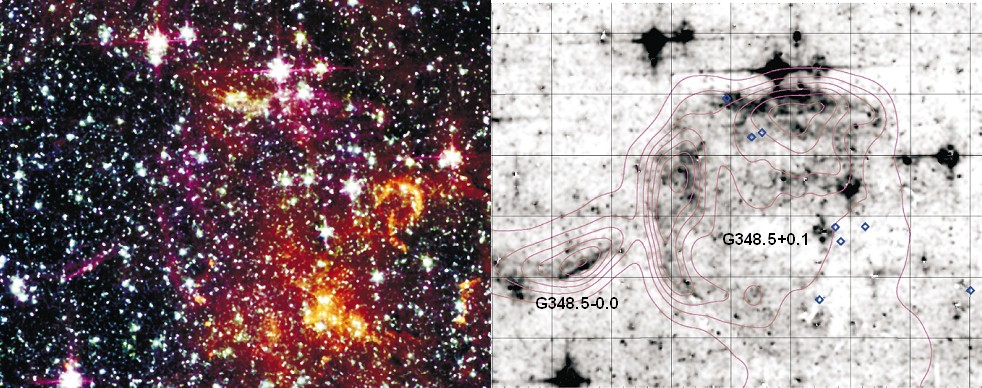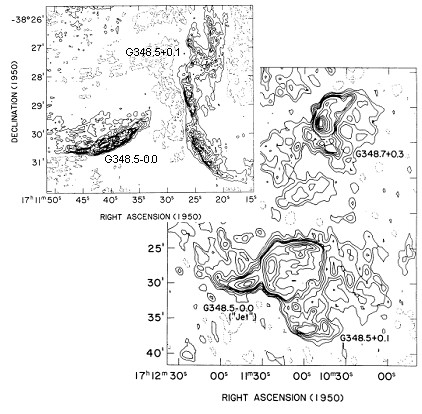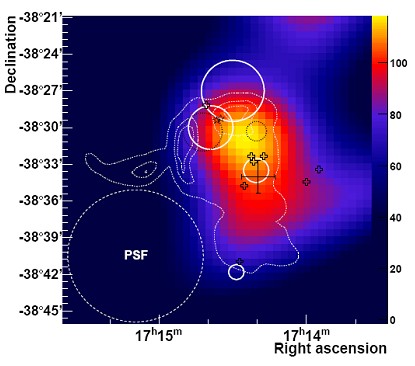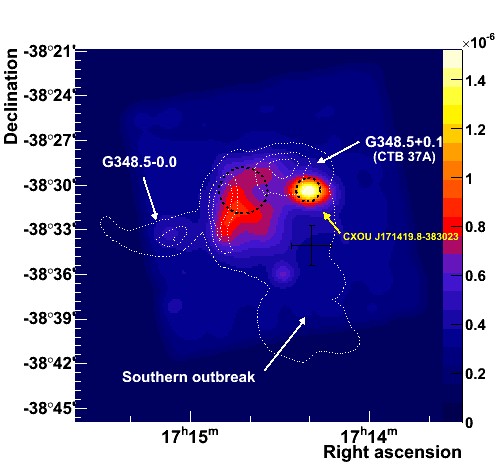The Supernova Remnant CTB 37A
June 2008

The field around the Supernova remnant RXJ 1713.7-3946 (see SOM 4/08), which has received a particularly deep H.E.S.S. exposure, reveals three additional gamma-ray sources: HESS J1718-385 (SOM 6/07), HESS J1713-381 (SOM 4/08) and the source covered this month, HESS J1714-385, coincident with the supernova remnant CTB 37A. The top figure shows an infrared image of the CTB 37A region, where two supernova shells (G348.5+0.1, G348.5-0.0) are visible as magenta filaments. The shells are better visible in radio (Fig. 1). The complex around Galactic longitude 348 contains three partial shells: G348.7+0.3 (also known as CTB 37B, see SOM 4/08), G348.5+0.1 and G348.5-0.0. In the deep H.E.S.S. exposure, the faint gamma-ray source HESS J1814-385 is visible near the center of the G348.5+0.1 shell (Fig. 2). The source is extended, with a rms size of about 4', but since it is very faint - only about 3% of the flux from the Crab Nebula - no detailed morphological information can be extracted from the gamma-ray image. The energy spectrum of gamma rays is relatively hard, with a spectral index around 2.3. Follow-up observations of the region in X-rays using Chandra result in the X-ray image shown in Fig. 3, with two extended regions of X-ray emission: a wide region of thermal emission near, but not exactly coincident with, the radio shell, and a brighter non-thermal source which could be a signature of a X-ray pulsar wind nebula, which would make a G348.5+0.1 a composite remnant.
What is the nature of the very high energy gamma ray emission in this object? The presence of OH maser emission (crosses and stars in Fig. 2) indicates that the supernova shock wave visible in the radio images interacts with molecular clouds (white circles in Fig. 2), which would also provide a target for protons accelerated in the supernova shock, resulting in gamma-ray production. The detection of thermal X-ray emission from inside the shell may provide further evidence that the supernova blast wave has interacted with dense clouds. With an estimated distance of the remnant around 10 kpc and an approximate mass of the target clouds of order 104 solar masses, an energy in accelerated protons of about 3x1050 ergs would be required, within the large uncertainties associated with this estimate consistent with the expected yield. Another scenario is a leptonic origin of the gamma-rays, by up-scattering of ambient photons by high-energy electrons of the pulsar wind nebula visible in the X-ray image. The gamma-ray source is larger than the X-ray source and slightly displaced, but these features are observed for many other pulsar wind nebulae detected in gamma rays. Using the X-ray flux to estimate the spin-down energy loss of the pulsar suspected at the core of the nebula, a conversion of about 0.1% of the energy loss into gamma-rays is required to explain the observed gamma-ray flux, again well within the range observed for other similar objects. More detailed studies at other wavelengths will be required to confirm or reject this scenario.
References:
Discovery of a VHE gamma-ray source coincident with the supernova remnant CTB 37A, H.E.S.S. collaboration, F. Aharonian et al., arXiv:0803.0702

